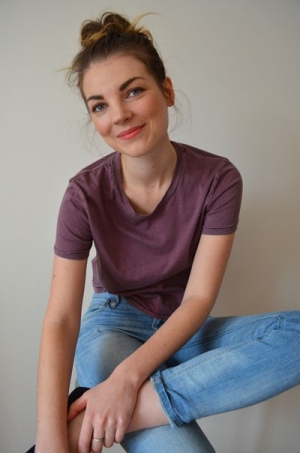She also founded the annual publication Spiffy Moves, which features experimental art writing alongside print-friendly visual art projects by Concordia students and alumni.
“I think a lot of the time art writers and art historians are thought of as reporters,” Webb says. Much of the catalogue’s text is presented in a fact-based, objective tone — a style that is heavily embedded in the discipline, she explains.
She believes that if writers incorporate subjective impressions and experiment with form and structure, they have the potential to bring a new element to the work. This places the writing alongside the artwork, rather than being secondary to it.
Webb, who is the first emerging art writer to edit the catalogue, encouraged students to play with form by rethinking the way they have been taught to write about art.
“You don’t have to write an art review or an exhibition catalogue entry in a prescribed way; you can have fun with these different formats,” she says.
The catalogue’s writers met with their assigned artist over several months and produced several drafts of text, which Webb says provided ample opportunity for creative feedback.
One student had the idea of writing in a way that mirrored the work that he was writing about by using repetition stylistically in his text. The resulting essay reads almost lyrically, like a poem.
“It’s a great professional opportunity,” Webb says. “A lot of young artists have never had someone write about their work.”
It’s an equally great opportunity for aspiring art writers looking for guidance, mentorship and experience. “Students get the chance to work with an editor and go through the process of reworking drafts, which helps them to find the way that they feel comfortable writing about art,” she says.
The 28th Annual Undergraduate Student Exhibition and its accompanying print catalogue are the result of a partnership between Concordia’s undergrad studio arts, art history and design programs.
After being selected to exhibit their work in this annual exhibition, artists in the studio arts program are paired with a writer from the art history program. Working closely with the artist and editor, the writer produces an accompanying essay that is displayed alongside the artwork in the exhibition catalogue.
Using the images and words as inspiration, students in the design program lay out and publish the print catalogue that can be purchased for $10 at the FOFA Gallery, located at 1515 Ste. Catherine St. W.
The Echo Game — the title for this year’s edition — reflects the exhibition’s goal: to encourage viewers to contemplate on the impermanency of time (echo) while engaging with the work in a playful manner (game).
It features 11 works by 12 artists and ran from January 11 to February 19.
 Nancy Webb encouraged undergraduates to use experimental writing in this year’s Faculty of Fine Arts Undergraduate Student Exhibition catalogue. | Photo courtesy of Nancy Webb
Nancy Webb encouraged undergraduates to use experimental writing in this year’s Faculty of Fine Arts Undergraduate Student Exhibition catalogue. | Photo courtesy of Nancy Webb